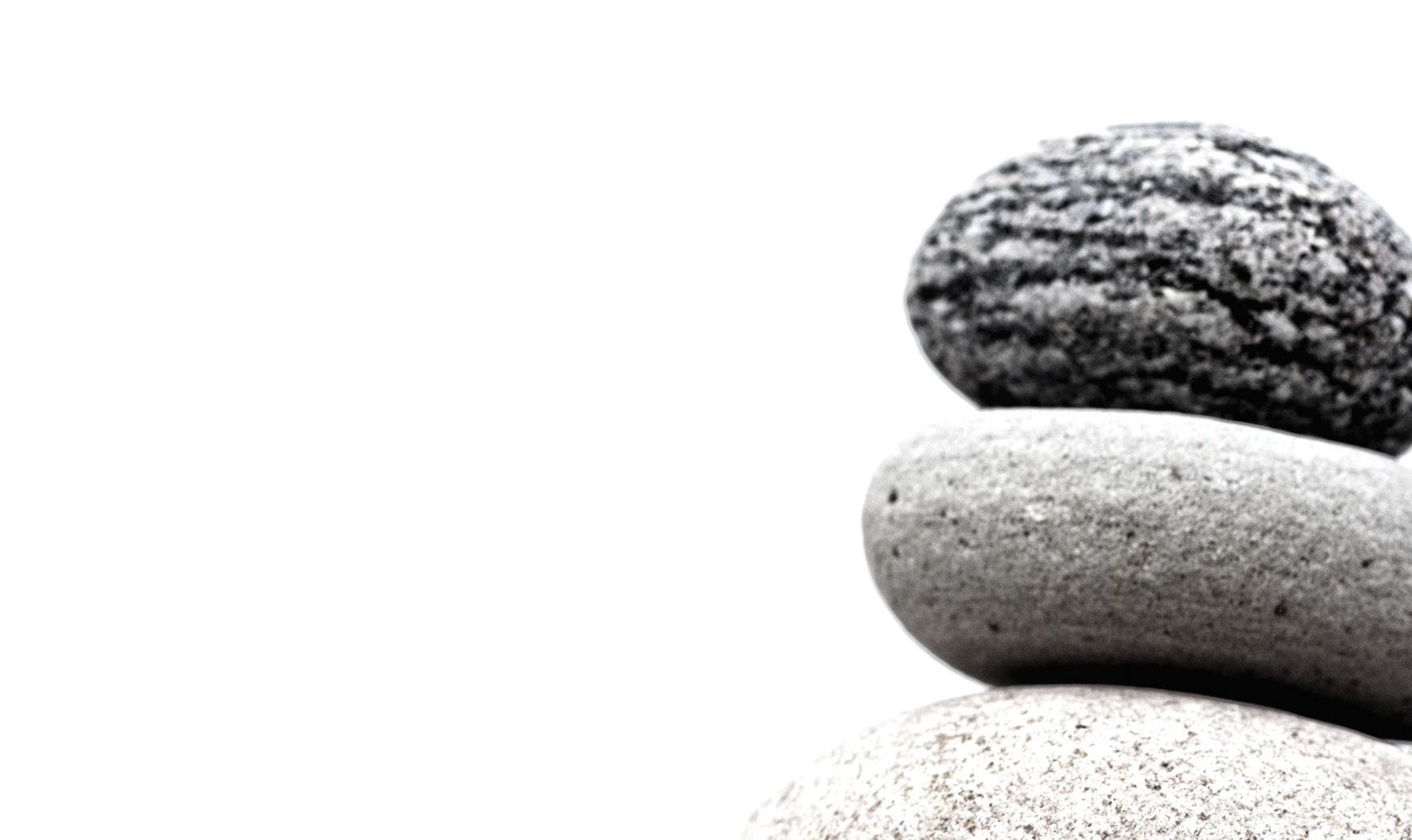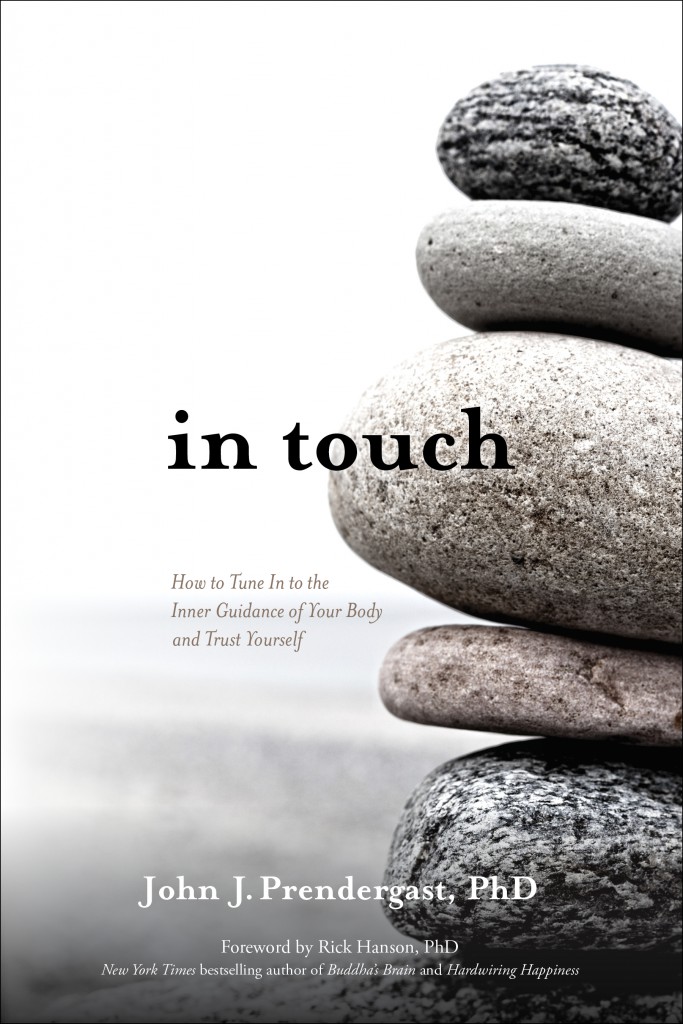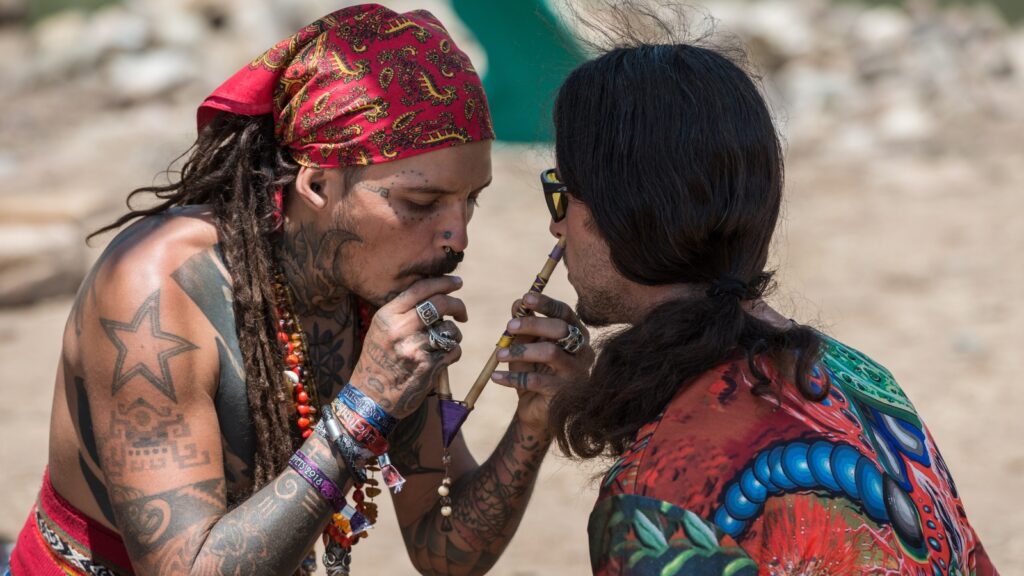The following is excerpted from In Touch: How to Tune into the Inner Guidance of Your Body and Trust Yourself. Published by Sounds True, April 2015.
Self-recognition
We cannot understand, love, and welcome others without first knowing and loving ourselves. –Jean Klein
Our body’s deep sensitivity is calling us home. Yet home is not somewhere, some when, or something other than what is already wholly present now. Our true nature is not some inner state that will be found in the future. It is always here and now, unbounded by space or time. It can never be objectified. Further, the heart of the one who is looking—the apparent separate self—is what is being looked for. Nisargadatta Maharaj said it most succinctly: “The seeker is the sought.”
This wisdom teaching is very puzzling for the linear mind that thinks in terms of someone attaining something. A student of the Indian sage Ramana Maharshi once asked for help to find his true nature. “You are like a man standing in his living room, asking how to get home,” Ramana replied. We are already home—we just don’t realize it. Infinite awareness is shining through your eyes as you read this—you are not who you think you are. Take a moment to open to this possibility.
Our body’s inner knowing is pointing us toward this self-recognition. Certainly being relaxed, grounded, aligned, spacious, and openhearted makes day-to-day living much easier, but there is a deeper invitation at work within each of us—to wake up. Self-recognition and awakening are different ways of describing the same thing. At some point we realize that we are not the limited being that we consciously and subconsciously take ourselves to be. We see that none of our stories and images about ourselves are actually true. This initial recognition can feel as if the clouds have briefly parted, revealing a vast, open space.
When this happens, the veil of personal identity temporarily lifts, and we know ourselves as open, awake awareness. We are in touch with our natural lucidity. In rare instances this awakeness is sustained after the first contact. In most cases, however, the conditioned bodymind reasserts itself, and there is a return to one’s familiar identity. Yet a taste of this homecoming remains. It is like someone who briefly awakens from a dream and then falls asleep again; the wakefulness is never completely forgotten. It continues to vibrate on the periphery of the dream, in the background of who we imagine ourselves to be. Our lives start to reorient around this clearer sense of who we really are.
As a result, we may begin to slow down and start paying attention to our actual experience. We may tune in to the sensations of our body or start to notice moments of silence between thoughts. We may question our limiting beliefs and emotional reactions and become interested in the process of how we bind and blind ourselves. Or, as Adyashanti puts it, we become interested in “the pitfalls and cul-de-sacs that un-enlighten us along the journey.”
“How do I unenlighten myself?” is a subtly different question from “How do I awaken?” The former presumes that we are obscuring a natural wakefulness that is already here. Rather than wondering how we get there, we can inquire, “Is it true that what I seek is not already here?” I invite you to sit with these questions and feel what they evoke. Something in you will respond if you don’t go to your thinking mind for an answer.
Awakening does not come from moving forward, but from falling back. It is a letting go into the unknown. In Zen it is called “the backward step.” We start to track our experience backward. For instance, you can evoke the sense of “I am” and then follow it back to its source—a classic form of self-inquiry. What happens if you focus your attention on the thought “I am”? Can you sense where and how it localizes in your body? If you follow it inward, where does it draw your attention? Or you can feel the deep yearning of the heart to come home and follow that yearning back. These kinds of intuitive inquiries
lead us out of the certitude of the conditioned mind into the unfamiliar territory of “I don’t know.”
The mind may think that “I don’t know” is the wrong answer to the question “Who or what am I?” Yet, in fact, “I don’t know” is the most accurate and honest answer. When we deeply investigate all of our placeholder identities, such as being a man or a woman, an American or a German, a white, a brown, or a black, a hetero- or homosexual, they fall to the side like name tags scattered on the floor at the end of a convention. The simple truth is that we actually don’t know who we are. Gradually we learn to relax into this not knowing. As Jean Klein once told me during a private interview, “Abide in the heart, not knowing.”
At some point, having made ourselves available, we are taken by grace. This taking may be sudden and clearly recognizable or slow and barely noticed—a waterfall or a broad river gently meeting the ocean. Whether sudden or gradual, there is a gravitational shift of identity from form to formless, from being someone to being no one, from being an object bounded by time and space to being open, awake, and infinite awareness. There is clarity, with no one left to claim it as his or her own. It marks the beginning of a new chapter of life.
Presence and Present-Centeredness
As we discover who we really are, there is a natural presence that unfolds like the fragrance from a blossom. I think of it as the radiance of being. It is completely uncontrived and spontaneous. It is also gently contagious. I remember sensing it with both of my main teachers, Jean Klein and Adyashanti, even though they had completely different personalities, backgrounds, and teaching styles. The first time that I met each of them, I immediately dropped into a deep, vibrant silence. What was wakeful in me could sense it in them. None of this was mediated by thought.
Some spiritual traditions call this phenomenon “transmission,” implying that something is being given or transmitted. Certain energies can be willfully directed, but this is not what was happening when I sat with my teachers. They were simply being themselves. I was just sitting in their presence without any direct visual or verbal contact.
Transmission is actually resonance. The truth of who we are resonates with itself in others. Being shines through a particular being and invites itself into the foreground of awareness in other beings. The most important sharing happens in silence. Words are secondary, mainly helping the mind to see its limits and to relax. An effective outer teacher points students to their own inner teacher. There is really only one teacher—our inner knowing.
There is a meaningful distinction between present-centered and presence that is often overlooked. The former can be a doorway to the latter, but this is not always the case. Being present-centered means focusing attention on present experience. For example, right now I am aware of the sound of a passing car, the contact between my body and the chair that I am sitting in, the afternoon light outside my study, my breath, a feeling of quiet contentment, and a sense of wonder about what thoughts and words are about to appear. In other words, I am aware of sensations, feelings, and thoughts; these are the contents of awareness.
Presence refers to the recognition of awareness itself, to the context of experience rather than the content. This spacelike awareness feels open, awake, and full of potential. There is a sense of being—not being anyone in particular, just being. Within this presence there are fluctuating degrees of present-centered attention, like waves on the ocean. The waves can be in different states—sometimes very calm, as is the case for me right now, and sometimes rather choppy and fragmented, for example, when I am distracted and not really paying full attention to what is going on in front of my nose. (My wife is good at pointing out the latter moments, which is both humorous and humbling.) Regardless of what is happening on the level of present experience, there is an awareness of an openness within which it is happening.
The distinction between presence and present-centeredness affects how we understand and approach spiritual practice. Some traditions insist that the mind must first learn to focus and be quiet before a deeper realization of one’s true nature can happen. From this perspective, students who are advised to “rest in and as open awareness” without having first learned how to focus their attention on an object such as the breath or a mantra will spend the vast majority of their time daydreaming or restlessly fidgeting.
There is some truth to this observation. I have been on long retreats where some participants report experiencing this restlessness. In my own case, I spent nearly ten years doing a mantra meditation that served as a subtle anchor for attention. Later, when I adopted a practice of simply resting in silence, it was an easy and liberating transition. The preceding years of subtly focusing attention may have helped. It is hard to know. Some people don’t seem to need this prior training. For others, a regular sitting meditation practice can be quite lovely and beneficial. For yet others, meditating on an object can become an obstacle over time, leading to a feeling of inner dryness. You have to find what is true for you.
If you are interested in a sitting meditation practice, try it and see how it goes. If you have difficulty simply resting in silence, you may want to begin the meditation with a focus of attention, such as the breath in the lower belly (hara) or the heart center. As the mind becomes quieter while you sit, experiment with letting the focus go and resting in awareness.
Presence is not cultivated; it is uncovered. In rare cases this uncovering can be sudden and quite dramatic. Sometimes an extreme health or relational crisis will trigger a sudden letting go and opening when someone has had absolutely no spiritual background or practice. Byron Katie is a great example of someone who experienced this sudden uncovering.1 These kinds of openings initially tend to be accompanied by lots of inner and outer upheaval. Generally speaking, the more balanced and integrated the body-mind is, the easier it is to rest in and as simple awareness. Yet there are no preconditions for recognizing who we are; there don’t seem to be any hard and fast rules.
We can be relatively present-centered without being aware of presence. And we can be aware of presence without being particularly present-centered. They are different domains. That said, present-centered attention is a common portal to self-recognition and presence. In any case, it is always useful to pay attention.
Self-Trust, Inner Authority, and Autonomy
When we are willing to not know who we are and to free ourselves from the cage of the conditioned mind, a different kind of knowing emerges, one that is more heartfelt and whole-bodied. While this more direct, moment-to-moment way of knowing does not confer omniscience, it does allow us to be more in touch with ourselves and to grow in self-trust, inner authority, and autonomy.
Self-trust is difficult as long as we identify with the critical intellect. This was certainly true in my case. I struggled with self-doubt even after having many years of meditation and wisdom teachings under my belt. This shifted when I attended my first weeklong retreat with Jean Klein in 1986 in the mountains south of Santa Cruz, along the California coast. In the mornings, in a room overlooking redwood groves and the Monterey Bay, Jean would lead the group in what he called his “body approach”—a very slow and gentle form of yoga that emphasized sensing the body’s subtle energy and spaciousness. In those days, he would walk among us, quietly observing and, more rarely, making small corrections to our posture. At one point, as I did a seated twist, I could sense him standing behind me. I then felt the slight upward brush of his finger behind my heart center. To my surprise, I spontaneously visualized a vertical line running along my spine and the repair of an inner, unknown fracture in my heart. That night I dreamed that I pulled out of one of my ears a large worm that had burrowed deep in my brain. As I did, I knew that this disgusting parasite was my self-doubt. I also knew that Jean’s gentle touch had somehow facilitated its release.
This was a turning point in developing self-trust. Before it, I was prone to self-doubt and continually questioning the validity of my direct experience. If there were periods of inner peace and joy or moments of genuine insight and openness, afterward I would wonder whether they were real or just fabrications of my mind. I was deeply identified with the judging mind that relentlessly questioned everything, including my direct experience. While my self-doubt didn’t change overnight after this experience, I began to see my doubt more clearly for what it was—a distorted lens through which I viewed myself and the world. In a certain way, I began to doubt my doubt and to trust the knowing of my heart.
The conditioned mind is always strategizing, seeking to avoid pain and to increase pleasure. It is driven by fear and desire. This is its job. In contrast, our inner knowing is interested in the truth—how things actually are. It has no agenda to survive, fit in, be admired, or to feel better. It is concerned with love, wisdom, integrity, and being in service to the whole of life.
As we learn to slow down, tune in to our inner guidance, and act on it, our self-trust grows. We increasingly get the feel for when something resonates as being true or false for us, in or out of accord. This sense of inner resonance becomes our inner authority. We gradually wean ourselves from convention and learn to think and feel for ourselves. We withdraw the projection of authority onto others as we recognize it in ourselves. As a result, we are less likely to follow outer authorities unless it is clear that they are in touch with a deep authority within themselves. Our self-trust comes from the felt sense of this inner authority.
Trusting our inner authority brings spiritual autonomy, the ability for true self-governance. It is the entrance into real adulthood. We are willing and able to stand on our own. Yet this inner freedom and independence is not egocentric or disconnected from others. As we trust our inner authority more, we are less defensive and more available to meet and love life as it is. Our autonomy is not based upon some ideology or need to be right. It does not take a rigid position. True autonomy adapts to the revelation of new facts and insights.
Some of my clients and students occasionally express ambivalence about trusting their inner authority because they fear the loss of connection with others. There is a deep fear of isolation and aloneness. Yet the fear of aloneness is rooted in our belief that we are a separate self. Abdicating our authority and merging with others only masks this underlying fear of aloneness and isolation. As we learn to trust who we really are and not who we think we are, we discover that we are not essentially separate from anyone. We are unique, free, and unimaginably interconnected. The recognition of our true inner autonomy allows us to enjoy our human interdependence. As we grow in self-trust, we can give and receive that much more freely. It is a joy to do so.
Embodiment
I suggested earlier that self-recognition or awakening is the beginning of a new chapter of life, one that could be entitled “Embodiment.” It is one thing to realize our infinite nature on the level of the mind; it is another to do so on the level of feelings and sensations. This is a more challenging process because emotional and instinctual conditioning runs far more deeply than mental conditioning. We can be disidentified from our mental stories and images and continue to be very identified with our emotional and instinctual patterns, which we unconsciously act out. There may be a sizable gap between our inner realization and the way that we lead our daily lives, depending upon our conditioning and the psychological work we have already done on ourselves. It is a question of congruence. How aligned is our living with our knowing?
If we remain open, the process of waking up from form and realizing that we are no one and no thing is followed by a process of waking down into form. It is wonderful to know and to experience that we are not bounded by anything, yet it is a negative freedom—a freedom from. We are still residing in a subtle state of separation from all that we are free of. There is still a knower and a known. But what remains, if not oneself? Are we free to fully enter into form, particularly this body?
Spiritual traditions with an imbalanced transcendental and masculine emphasis stop here, either devaluing or entirely dismissing emotions and the body. After all, once you know yourself as the infinite, why bother with the finite? If we see spirit as only being transcendent and formless, we will want to dwell there. If we understand that spirit is both transcendent and immanent, we will want to discover and live it in our ordinary life. The consequences of our view are huge.
Our body is form par excellence. As Jean Klein noted, it is our “nearest environment.” The more clearly we sense that our body is an expression of pure awareness, the more deeply we sense this of the world. There is a direct correspondence: as we are with our body, so we are with the world. As the true nature of the body is discovered, the world becomes an increasingly transparent expression of consciousness.
My friend Rupert Spira describes this transformational process as awareness colonizing the body.2 Awareness saturates the conditioned body. Deeper levels take more time to touch and transform. For me, awake awareness has been spontaneously, relentlessly, and sometimes arduously drilling down through the bedrock of conditioning for the last decade. As this process continues and deepens, lingering distinctions between knower and known dissolve. Only knowing remains, and a great intimacy begins to reveal itself.
Notes
1 Katie, Byron. Loving What Is: Four Questions That Can Change Your Life. New York: Crown Archetype, 2002.
2 Spira, Rupert. Presence: The Art of Peace and Happiness, vol. 1. Salisbury, UK: Non-Duality Press, 2011.
_______. Presence: The Intimacy of All Experience, vol. 2. Salisbury, UK: Non-Duality Press, 2011.










